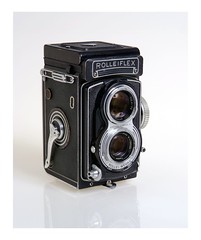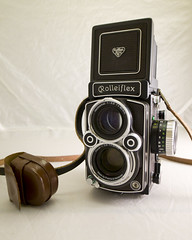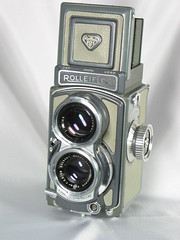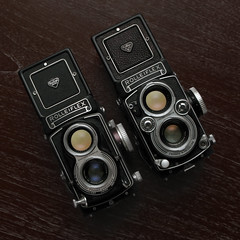Difference between revisions of "Rolleiflex"
(Noted that 'Rolleiflex' name is also used on non-TLR cameras,and linked back to relevant sections of Rollei. Replaced 120 mm with 6x6) |
(Noted relationship with the Rolleidoscop.) |
||
| Line 6: | Line 6: | ||
Rollei also used the name '''Rolleiflex''' for several ranges of [[Rollei#Medium Format SLR|medium-format SLR]] and [[Rollei#35mm SLR|35mm SLR]] cameras from the late 1960s to the 90s, one [[Rolleiflex SL26|SLR for 126 film]], and one digital camera. However, the name is most closely associated with the TLR cameras. | Rollei also used the name '''Rolleiflex''' for several ranges of [[Rollei#Medium Format SLR|medium-format SLR]] and [[Rollei#35mm SLR|35mm SLR]] cameras from the late 1960s to the 90s, one [[Rolleiflex SL26|SLR for 126 film]], and one digital camera. However, the name is most closely associated with the TLR cameras. | ||
| − | The Rolleiflex TLR with its simple construction and high quality optics was a widely used professional camera | + | The Rolleiflex TLR was first made in 1927, shortly after the [[Rolleidoscop]], a stereo camera with a focusing reflex viewfinder, and might be seen as derived from it. With its simple construction and high quality optics, the TLR was a widely used professional camera, but the late fifties introduction of much more versatile SLR cameras in 35mm (Nikon) and 6x6 (Hasselblad) formats spelled the end. Rollei did later introduce SLR cameras but never regained their market position. |
One of the early Rolleiflex innovations was the speed winder whereby a single turn of the winder handle advanced the film and cocked the shutter. This seemingly simple innovation, which required quite complex gearing, transformed the camera especially compared to plate cameras that were still commonly used by press photographers well into the fifties. Popular with press and sports photographers, the camera was also popular with fashion photographers. The in lens leaf shutter meant flash could be used at any shutter speed and the reflex image was bright since the separate viewfinder lens had a large aperture. | One of the early Rolleiflex innovations was the speed winder whereby a single turn of the winder handle advanced the film and cocked the shutter. This seemingly simple innovation, which required quite complex gearing, transformed the camera especially compared to plate cameras that were still commonly used by press photographers well into the fifties. Popular with press and sports photographers, the camera was also popular with fashion photographers. The in lens leaf shutter meant flash could be used at any shutter speed and the reflex image was bright since the separate viewfinder lens had a large aperture. | ||
Revision as of 11:27, 16 January 2012
| |||
| German TLR () | |||
|---|---|---|---|
| 35 mm | Contaflex | Flexilette | Optima Reflex | ||
| 3×4 | Pilot Reflex | ||
| 4×4 | Baby Rolleiflex (1931) | Baby Rolleiflex (1957) | Karma-Flex | ||
| 6×6 | Altiflex | Amplion Reflex | Brillant | Flektar | Flexo | Flexora | Flexora II | Flexora III | Foth-Flex | Ikoflex 1 | Ikoflex II | Ikoflex Ia | Ikoflex Ic Ikoflex Favorit | Karma-Flex | Mentorett | Montiflex | Peerflekta | Perfekta | Photina Reflex | Plascaflex | Reflecta | Reflekta | Reflekta II | Rica Flex | Rocca Automatic | Rocca Super Reflex | Rolleiflex | Rolleicord | Rollop | Superb | Superflex | Trumpfreflex | Vitaflex | Weltaflex | Wirgin Reflex | Zeca-Flex | ||
| 6×9 | Superfekta | ||
Rolleiflex is the name of most of the 6×6 TLR cameras manufactured by Franke & Heidecke and later Rollei GmbH, in Germany. There was also a range of less expensively specified models named Rolleicord.
Rollei also used the name Rolleiflex for several ranges of medium-format SLR and 35mm SLR cameras from the late 1960s to the 90s, one SLR for 126 film, and one digital camera. However, the name is most closely associated with the TLR cameras.
The Rolleiflex TLR was first made in 1927, shortly after the Rolleidoscop, a stereo camera with a focusing reflex viewfinder, and might be seen as derived from it. With its simple construction and high quality optics, the TLR was a widely used professional camera, but the late fifties introduction of much more versatile SLR cameras in 35mm (Nikon) and 6x6 (Hasselblad) formats spelled the end. Rollei did later introduce SLR cameras but never regained their market position.
One of the early Rolleiflex innovations was the speed winder whereby a single turn of the winder handle advanced the film and cocked the shutter. This seemingly simple innovation, which required quite complex gearing, transformed the camera especially compared to plate cameras that were still commonly used by press photographers well into the fifties. Popular with press and sports photographers, the camera was also popular with fashion photographers. The in lens leaf shutter meant flash could be used at any shutter speed and the reflex image was bright since the separate viewfinder lens had a large aperture.
The biggest disadvantage of a fixed lens was only partly addressed by versions with different focal lengths.
Contents
Rolleiflex TLR models
"Original", "standard" and f/3.5 models of Rolleiflex
- Original Rolleiflex 6×6 (1928-32)
- Rolleiflex old standard model 620 (1932-38)
- Rolleiflex old standard model 621 (1932-35)
- Rolleiflex old standard model 622 (1934-38)
- Rolleiflex Automat 6×6 Model 1 (1937-39)
- Rolleiflex Automat Model 2 (1939-45)
- Rolleiflex New Standard (1939-41)
- Rolleiflex Automat Model 3 (1945-49)
- Rolleiflex Automat Model X (1949-51)
- Rolleiflex Automat Model 4 (1951-54)
- Rolleiflex 3.5 MX-EVS (1954-56)
- Rolleiflex 3.5 E (1956-59)
- Rolleiflex 3.5 E2 (1959-60)
- Rolleiflex 3.5 E3 (1961-65)
- Rolleiflex T 1 (1958-66)
- Rolleiflex T 2 (1966-71)
- Rolleiflex T 3 (1971-76)

|
| Rolleiflex T image by RIchard Frances (Image rights) |
- Rolleiflex 3.5F Model 1 (1958-60)
- Rolleiflex 3.5F Model 2 (1960)
- Rolleiflex 3.5F Model 3 (1960-64)
- Rolleiflex 3.5F Model 4 (1965-76)
- Rolleiflex 3.5F Model 5 (1979)
Rolleiflex 2.8
- Rolleiflex 2.8A Type 1 (1949-51)
- Rolleiflex 2.8A Type 2 (1951)
- Rolleiflex 2.8B (1952-53)
- Rolleiflex 2.8C (1952-55)
- Rolleiflex 2.8D (1955-56)
- Rolleiflex 2.8E (1956-59)

|
| Rolleiflex 2.8FX image by Bellamy Hunt (Image rights) |
- Rolleiflex 2.8E 2 (1959-60)
- Rolleiflex 2.8E 3 (1962-65)
- Rolleiflex 2.8F (1960-81)
- Rolleiflex 2.8F 2/3 (1966-76)
- Rolleiflex 2.8F 4 (1976-80)
- Rolleiflex 2.8F Aurum (1982-84)
- Rolleiflex 2.8F Platin (1984-90)
- Rolleiflex 2.8GX (1987-2002)
- Rolleiflex 2.8GX Edition 1929-1989 (1989-91)
- Rolleiflex 2.8GX Helmut Newton Edition (1992-93)
- Rolleiflex 2.8FX (2002-current)

|
| Rolleiflex 4×4 image by Takekazu Omi (Image rights) |
Rolleiflex Baby
- prewar Baby Rolleiflex:
- Rolleiflex Baby 4×4 1931 (1931-32)
- Rolleiflex Baby 4×4 1933 (1933-34)
- Rolleiflex Baby 4×4 1934/8 (1934-38)
- Rolleiflex Baby 4×4 1938 Sport (1938-43)
- postwar Baby Rolleiflex:
- Rolleiflex Baby 4×4 1957 Grey (1957-63)
- Rolleiflex Baby 4×4 1963 Black (1963-68)

|
| Rolleimagic image by John Nuttall (Image rights) |
Tele Rolleiflex
- Tele Rolleiflex (1959-74), 8,378 built
- Rolleiflex 4,0 FT (2007-current)
Rollei Magic
- Rollei Magic I (1960-62)
- Rollei Magic II (1962-68)
Wide-Angle Rolleiflex
- Wide-Angle Rolleiflex (1961-67)
- Rolleiflex 4.0 FW (2002-current)
Links

|
| Rolleiflex 3.5 E3 and T image by Matt Phillips (Image rights) |
In English:
- Rolleiflex TLR Price & Model Identification Guide by Dan Colucci at www.antiquecameras.net
- Rolleiflex TLR Forum a complete Rolleiflex discussion forum and community
- All Rollei TLR by year at the International RolleiClub, a comprehensive overview with variants, specs, production estimates and serial numbers
- Rolleigraphy website by Ferdi Stutterheim
- Rolleiflex TLR site by Torbjorn Aase
- Serial number list by Peter Rongsted
- Rolleiflex TLR manuals in PDF format hosted at medfmt
- User manuals for various Rolleiflex models at butkus.org's Orphan Cameras
- Rolleiflex I Original, Rolleiflex Automat, Rolleiflex 2,8C, Rollei Grey Baby on www.collection-appareils.fr by Sylvain Halgand
- User manual Rolleiflex T on www.collection-appareils.fr by Sylvain Halgand
- Rolleiflex Automat of 1937 listed at number 17 in Jason Schneider's Top 20 Cameras Of All-Time on Shutterbug.
- Rolleiflex Price Guide by collectiblend
- Rolleiflex T review at Thorley Photographics by Thorley Bros.
- Picture Gallery using a Rolleiflex 3.5 Automat
